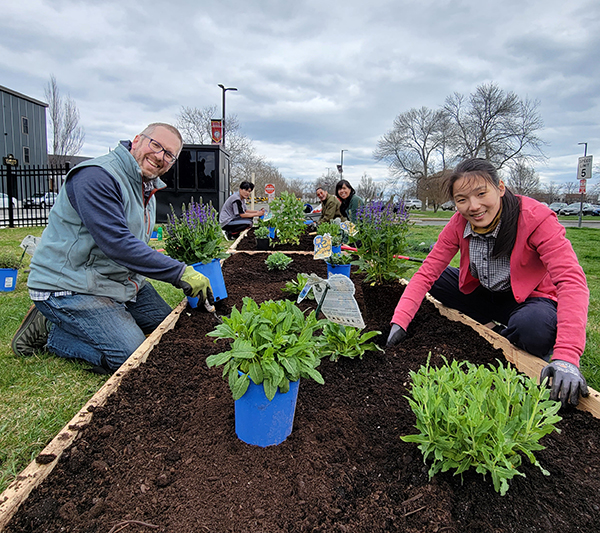April 23

The Environmental Club and the Horticulture Program, teamed up with our own NSCC Facilities folks in Lynn to expand our on-campus pollinator plantings.
You might remember our Broad street pollinator garden effort from last year. Our goal was to successfully support a diversity of pollinator species. Our design and location considered factors like bloom time of the flowers and how far different pollinators can travel. To that end, we made a mixed species garden of perennials that, with some care, will come back year after year.
We are happy to report the garden is looking great and coming alive with the spring weather. View photos on Flickr.
This year, the Environmental club chose a larger spot along Washington Street to create their second garden. This new garden is in full sun and hosts sun-loving perennials to more than double our square footage of pollinator plantings
Team work was key to making this project happen. NSCC Facilities assisted by constructing a raised bed and pitching in to move 46 cu. ft. of soil. Students and faculty designed, dug and planted over 70 new plants in their new location.
These concentrated plantings are not only pretty to look at but they create a dense plant community that attract and support pollinators throughout the growing season.
Just like last year, we chose plant varieties known to be preferred by pollinators, many of them native New England plants. We also chose a specific mix of bloom times so that there should always be flowers blooming throughout the season to keep the food supply up.
Here’s our list of this year’s plants:
Black-Eyed Susan – Rubeckia ‘Little Gold Star’
Blanket Flower - Gaillardia x Grandiflora, 2 colors, orange and yellow
Blue Fescue ornamental grass - Festuca glauca ‘Elijah Blue’
Blue Fortune Agastache – Agastache foeniculum
Dwarf Catmint – Nepeta faassenii ‘ Purrsian Blue’
Garden Pansy - Viola × wittrockiana
Sea Holly – Eryngium varifolium ‘Big Blue’
Tall Flowering Sedum - Stone Crop Sedum ‘Autumn Fire’
Woodland Sage - Salvia nemerosa, 3 colors, ‘April Night Blue’, ‘May Night Blue’, ’Snow Hill White’.
Yarrow - Achillea millefolium, 2 colors - ‘New Vintage Red’ & ‘New Vintage White’
We also added seed from eastern native Blue Lupine -L. perennis, and hope to see those grow too!
--Barbara Heath, Program Coordinator, Horticulture Program
